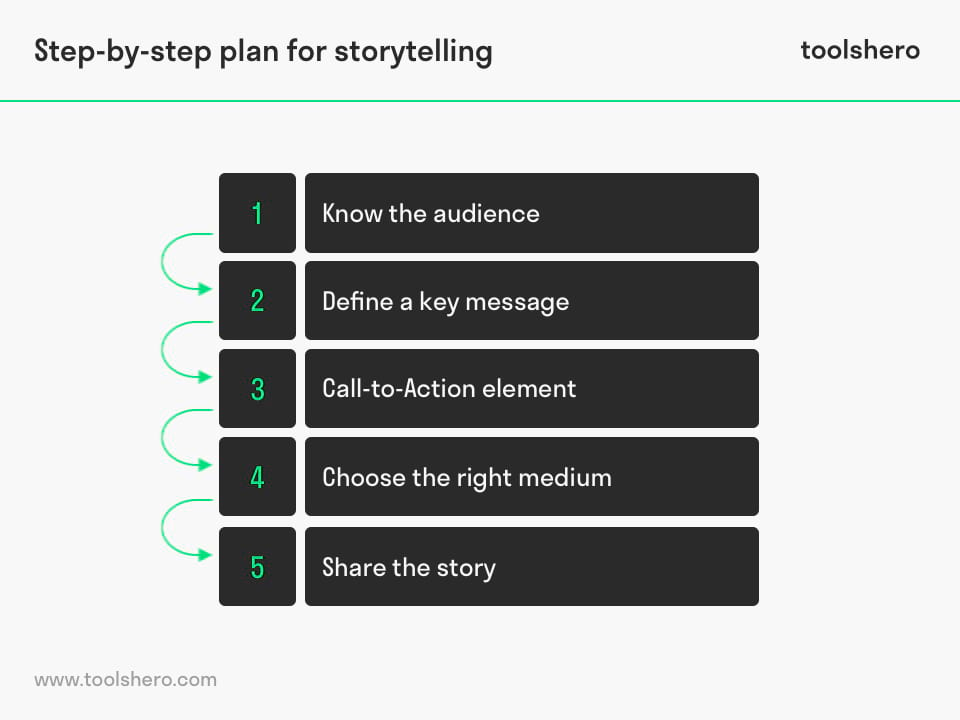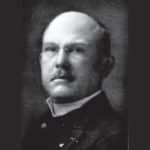Storytelling Method: Basics and Steps

Storytelling Method: this article provides a practical explanation of storytelling method. Next to what it is (definition), this article also highlights the origin, the general goal, an effective storytelling method, types and a step-by-step plan with practical elements to start with this great method. After reading, you’ll understand the basics of this powerful communication tool. Enjoy reading!
What is Storytelling?
The definition of Storytelling
Storytelling describes the social activity of sharing stories. Crucial story elements are plots, characters, and surprising angles. The term storytelling may refer to the verbal telling of stories, and in a broader sense to the techniques used in media to tell the story of a company or product.
In Marketing and design, storytelling is also used as a technique to gain insight into users, build empathy with users, and gain emotional access. With stories, designers use themes, staging, plots, and other techniques to increase the attractiveness of their offer.
What are stories?
Stories are often fascinating, and with good reason. From childhood to adulthood, people are attracted to stories and lessons they teach, the travels made, and the knowledge gained, combined with the possibility of unleashing our imagination.
Stories celebrate culture and are proof of the life that was led before today, and before everything could be recorded. Many people remember that wonderful primary school teacher who told stories about what he’d experienced and learnt, and forget that boring teacher who never told stories. People are social creatures with language as their ultimate means of communication. So, essentially, storytelling is the oldest form of knowledge transfer.
When did storytelling arise? The origin
Jack Zipes explains that people have been telling stories ever since they gained the ability to speak, and possibly even before, through sign language.
Initially, these stories functioned to mark danger, set an example, or relate an event. It also lead to attempts to explain the unexplainable through a fairytale or tall tale.
The Chauvet cave in France is the oldest representation of stories found thus far, dating back to approximately 36,000 years ago. Later forms of visual stories can be found in Egyptian hieroglyphics of about 3,000 years B.C.E.
What is the general goal of storytelling?
There are several effects of storytelling and these are representative of its goal. These reasons are explained below.
1. Simplification
Good stories strengthen abstract concepts that are difficult to understand and simplify complex messages. Everyone has at some point experienced confusion upon trying to understand a new idea or concept. Stories can then be helpful. A story helps to better understand a concept, such as in class with a mathematical problem for instance.
A good example of a company that effectively applies this technique is Apple. Computers and new technologies are complex to explain and describe to consumers.
Through stories, they show users exactly how Apple’s products can benefit their lives. No technical jargon, simply relatable information about the use of the device or service.
2. Stories unite people
Stories are told in every language and are often understood in all parts of the world. Everyone recognises the story about the hero or the underdog. Sharing and participating in a story can instill a sense of community in even the most diverse group of people. This is strengthened by the world that is shared by a multitude of people.
Despite language, political preferences, ethnicity or religion, stories connect people by expressing what we feel and the response to these emotions.
3. Stories inspire
Stories are purely human and the same is true for brands and companies. When brands become authentic and tell an exclusive and personal story, this will bring the consumer closer to the brand.
Brands inspire and motivate because they appeal to emotions. Eventually, this will lead to action; preferably the purchase of a product or service. Stories also encourage brand loyalty. Creating a story around a brand or product doesn’t just add a human factor, it also brings the organisation to a higher level.
GoPro is an example of a company that excels in this. GoPro sells small sports cameras that can be used to record all sorts of sports activities. Their small size makes the very easy to use and it yields spectacular images. GoPro uses the footage shot by amateurs to tell a story. Eventually, these film clips don’t just inspire people interested in sports, but the spectacular stories encourage consumers to buy a camera that allows them to shoot such footage as well.
What is the goal of storytelling in the business world?
Business goes beyond simply offering products and services in exchange for money. In Brand Management, you can read how important it is to build a strong brand. When creating the brand’s story, it’s important to emphasise what the brand stands for, what the brand’s voice is, and why it is important for the public. Storytelling is not a made-up tale, but rather the reason for a company’s existence, why these products or services are offered, and why the company does what it does, filled with stories.
Storytelling could be a goal in a specific project, but also a way to write content by connecting personal and existing stories to the brand.
However, not all content tells a story. Sometimes, content should be purely informative. Good stories don’t directly talk about a company, products, or solutions. Instead, they talk about needs and emotions in relation to the brand.
Stories constantly evolve and spontaneous changes often arise when stories circulate in a community, meme or event.
What is an effective storytelling method?
Stories must be personal to create attraction. When developing stories for business purposes, it’s important to keep the following in mind.
Think about how a brand came into being. What was the inspiration for the brand’s creation? And what is the business leader’s personal mission?
It’s important to connect these elements to the needs and emotions of the public. The story must be riveting and as factually accurate as possible. Customer stories have the highest long-term impact. This is due to the fact that stories evolve and are told to others.
The customer must be the main character in the story. In that case, the company is only the supporting factor that offers the customer the options and tools to create successful resolutions.
Types of storytelling
Stories can be made about pretty much everything, but they are particularly effective applied in the following ways.
Testimonials
A customer’s testimonial can be a powerful weapon for a company in building customer loyalty. The testimonial must be told in the right way. A testimonial of only a few sentences is quickly forgotten, but readers will remember a story that connects to a customer’s personal life and personal challenges.
Donations
An example. When a company that sells playground equipment sponsors a campaign aimed at purchasing new playground equipment for a local community centre, the company can write a story about this. Such a story would focus on why the equipment is needed and who will benefit from it.
The story must concentrate on one or several recipients and describe what the donation or campaign means for them. Make sure the organisation itself doesn’t receive too much praise. Praise should always come from a third party, not from a spokesman of a company.
Effective media
Each medium can be used to tell and share a story. Examples include blogs, videos, social channels, multimedia, and prints. Each medium evokes a different response from the audience, because it functions differently.
The key to success for a medium is knowing what story must be placed on what medium. Short and powerful stories/messages work well on the Internet and television, while online conversations, stories, conferences and seminars create a personal bond with the reader.
Step-by-step plan for storytelling: the elements
Telling stories is a language art. Just like all forms of art, stories require creativity. And practice. Painters and other artists all follow their own creative process in designing something new. The same is true of companies that tell stories.

Figure 1 – steps of a story via the storytelling method
Start with the first step to write your own story step by step.
1. Know the audience
It’s important to know who your story is intended for. Who profits from this story? And who will respond quickest? To write a good and fascinating story, it’s paramount that you understand your readers.
Therefore, it’s important to investigate before putting pen to paper.
2. Define a key message
Whether the story comprises a single page or 20, it must contain a key message. Just like the foundations of a house, this core must be recorded for moving on to the story.
Consider the example of the playground equipment manufacturer that made a donation to the community centre. What is the point of this story? Why is it important that children can play?
Try to summarise the whole story in a few sentences. If that’s impossible, it doesn’t have a key message, and the story must be rewritten.
3. Call-to-Action element
A Call-to-Action (CTA) determines what action the audience must undertake after reading the story. Think about what exactly you want the reader to do after reading. Should they also donate money? Take a course? Or record amazing sports activities with a sports camera? Call to action.
4. Choose the right medium
As previously discussed, stories can occur in many forms. Some stories are written and read, whereas others are told and heard. The medium you choose depends on the type of story, and the availability of resources such as time and money.
Different types of stories are:
- A written story in articles, books, blogs
- A spoken story such as a presentation, TED talk, pitch, etc.
- Audio reports such as a podcast
- A digital story such as animation, video and games
5. Share the story
As in all forms of content marketing, it’s important to share and promote the story. Depending on the chosen medium, it’s wise to share the story on social media or email. Written stories are much simpler to share than a video story, for instance. Although digital stories can also be effectively shared on media such as YouTube.
The higher the number of channels used to share the story, the higher the audience’s involvement is expected to be.
Now it’s your turn
What do you think? Do you recognise the explanation about storytelling? Can you write stories? And would you like to share a story with us? What do you believe is important to include in a good story? Do you have any other tips or additional comments? Do you recognise the story of companies you know?
Share your experience and knowledge in the comments box below.
More information
- Boje, D. M. (2008). Storytelling organizations. Sage.
- Fog, K., Budtz, C., & Yakaboylu, B. (2005). Storytelling. Berlin: Springer.
- Lambert, J., & Hessler, B. (2018). Digital storytelling: Capturing lives, creating community. Routledge.
- Robin, B. (2006, March). The educational uses of digital storytelling. In Society for Information Technology & Teacher Education International Conference (pp. 709-716). Association for the Advancement of Computing in Education (AACE).
How to cite this article:
Janse, B. (2020). Storytelling Method. Retrieved [insert date] from Toolshero: https://www.toolshero.com/communication-methods/storytelling/
Original publication date: 06/12/2020 | Last update: 04/10/2024
Add a link to this page on your website:
<a href=”https://www.toolshero.com/communication-methods/storytelling/”>Toolshero: Storytelling Method</a>












